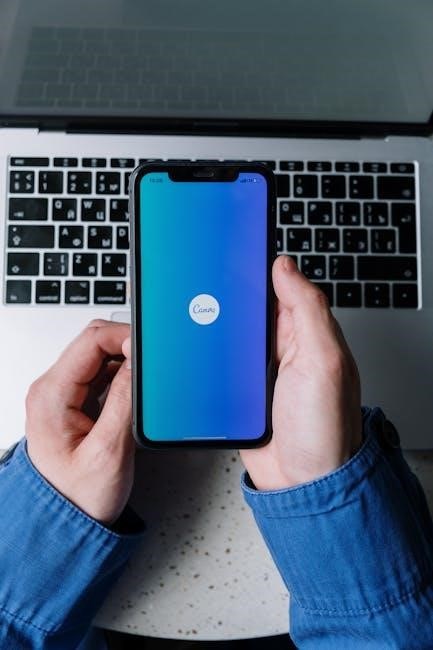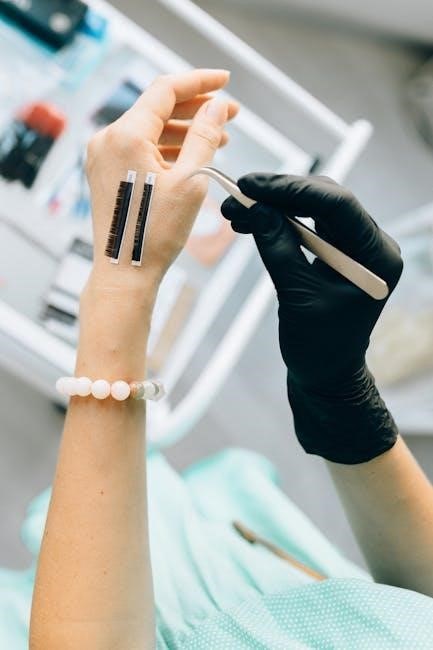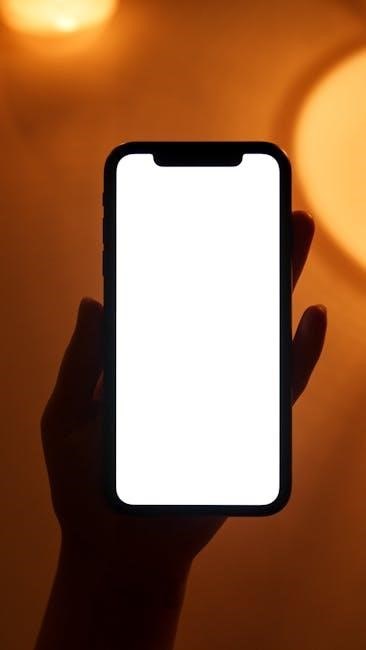What is a Provisional Patent?

A provisional patent application is a temporary application that provides a filing date for an invention, allowing further development before pursuing a full patent․
A provisional patent application is a temporary legal document filed with the USPTO to establish an early filing date for an invention․ It provides a 12-month window for further development, allowing inventors to refine their idea before pursuing a full patent․ Unlike a non-provisional patent, it does not require formal claims or an oath, making it simpler and cost-effective․ The provisional application includes a detailed description, background, summary, and often drawings to illustrate the invention․ It serves as a placeholder, protecting the invention’s priority date and preventing others from claiming the same concept during the development phase․ This tool is widely used by inventors and businesses to safeguard their intellectual property while preparing for the full patent process․
History and Evolution
The concept of provisional patents emerged to address the need for a cost-effective way to protect inventions during early development․ Historically, inventors faced challenges in securing timely protection while refining their ideas․ The provisional patent system was introduced to bridge this gap, providing a simpler and more affordable option․ Over time, its popularity grew due to its flexibility and strategic benefits․ Today, it is a cornerstone in intellectual property strategy, enabling inventors to establish priority without the complexity of a full patent application․ This evolution reflects the dynamic nature of innovation, where time and resources are critical in bringing ideas to market․ The provisional patent has become a vital tool, shaping modern approaches to intellectual property protection and fostering a culture of continuous improvement․
Importance in Modern Innovation
Provisional patent applications play a pivotal role in modern innovation by providing inventors and businesses with a strategic tool to protect their ideas during early development․ They allow for a 12-month window to refine concepts, gather feedback, and explore commercial potential before committing to the costly and complex non-provisional patent process․ This flexibility is particularly valuable for startups and entrepreneurs, enabling them to secure intellectual property rights without immediate financial strain․ Furthermore, provisional patents facilitate collaboration by providing a layer of protection when disclosing inventions to partners or investors․ They also offer a competitive advantage, deterring others from replicating ideas during the critical development phase․ By fostering a culture of iterative improvement and safeguarding innovative efforts, provisional patents have become indispensable in driving technological and creative advancements across industries․

Purpose and Function of a Provisional Patent
A provisional patent application establishes an early filing date, protecting inventions while allowing refinement and commercial exploration before pursuing a full patent․
Securing a Filing Date
Securing a filing date through a provisional patent application is crucial as it provides legal proof of the invention’s existence on that specific date․ This date acts as a priority date, ensuring protection against later filings by others․ The application must include sufficient detail to support the claims, although it doesn’t require formal patent claims or an oath․ Inventors gain a 12-month window to refine their invention, seek funding, or prepare a complete patent application․ This provisional date also allows for marketing and commercial activities without risking loss of patent rights․ Once the full patent is granted, the invention is retroactively protected from the provisional filing date, providing a strategic advantage in competitive markets․ This process is widely used by both individual inventors and businesses to safeguard their innovations early in the development process;
Protecting Inventions During Development
A provisional patent application plays a vital role in protecting inventions during their development phase․ By filing a provisional application, inventors can safeguard their intellectual property while continuing to refine their ideas․ This application serves as a placeholder, preventing others from claiming the invention during the development process․ It provides a grace period of 12 months, allowing inventors to test, market, and improve their creation without losing patent rights․ The provisional application also enables public disclosure of the invention for potential investors or partners, as it establishes a secure date for the invention’s conception․ This interim protection is essential for maintaining a competitive edge and ensuring that the invention remains novel and non-obvious during its refinement․ The provisional patent application thus acts as a strategic tool to balance innovation and legal safeguarding effectively․ This makes it indispensable for inventors and businesses alike in today’s fast-paced innovation landscape․
Strategic Benefits for Inventors and Businesses
Filing a provisional patent application offers significant strategic advantages for both inventors and businesses․ It provides an early filing date, which can be crucial in competitive markets where priority is essential․ This allows inventors to claim “patent pending” status, deterring competitors from copying their work․ Additionally, it provides a 12-month window to further develop and refine the invention, enabling the creation of a stronger, more comprehensive non-provisional application․ Businesses benefit by showcasing their innovation to investors, enhancing credibility and attracting funding․ The provisional application also facilitates collaboration and licensing opportunities, as it provides a secure basis for discussions․ This strategic tool helps manage intellectual property costs effectively, allowing for informed decisions on pursuing full patent protection․ Thus, it serves as a critical step in advancing innovation while safeguarding competitive interests both for individual inventors and organizations․ This approach ensures a balanced strategy between protection and development, making it a valuable asset in the innovation process․

Structure of a Provisional Patent Application
A provisional patent application typically includes a title, abstract, background, summary, detailed description, and drawings, providing a clear overview of the invention for future reference and development․
Title and Abstract
The title of a provisional patent application should concisely describe the invention, providing a clear indication of its purpose․ The abstract serves as a brief summary, typically no more than , outlining the invention’s key features, technical field, and advantages․ Together, they offer a snapshot of the invention, aiding in initial understanding and categorization․ Properly crafting these elements ensures clarity and effectiveness in communicating the invention’s essence․ Examples from provisional patent application PDFs demonstrate how titles and abstracts are succinct yet informative, balancing technical detail with broad accessibility․ These sections are critical for both examiners and potential readers, making them foundational components of a well-structured provisional patent application․ Their precision helps in guiding further development and patent strategies․
Background and Summary
The background section of a provisional patent application provides context for the invention, discussing existing technologies and identifying problems or limitations; It highlights the need for the invention and its significance in addressing these challenges․ The summary offers an overview of the invention, detailing its objectives, key features, and improvements over existing solutions․ Together, these sections bridge the gap between the abstract and the detailed description, offering a clear framework for understanding the invention’s purpose and innovation․
- The background often includes prior art and industry standards to contextualize the invention․
- The summary succinctly outlines the invention’s technical aspects and benefits․
- Examples from provisional patent application PDFs demonstrate how these sections effectively communicate the invention’s value and relevance․
These sections are essential for framing the invention’s importance and guiding the reader through its development and application;
Detailed Description and Drawings
The detailed description section of a provisional patent application provides an in-depth explanation of the invention, including how it works, its components, and how it achieves its intended purpose․ This section must be thorough enough to enable someone skilled in the field to replicate the invention․ Drawings, such as diagrams, flowcharts, or illustrations, are often included to visually represent the invention and its operational aspects․ These visual aids are particularly useful for complex inventions, helping to clarify the written description․ Examples from provisional patent application PDFs demonstrate how detailed descriptions and drawings work together to comprehensively disclose the invention․ The level of detail required ensures that the invention is fully understood and protects the inventor’s rights by establishing a clear record of the invention’s scope and functionality․

Examples of Provisional Patent Applications
Provisional patent application examples, such as those in PDF format, illustrate various inventions, including utility and design patents․ These examples provide practical insights into the application process․
Utility Patent Examples
Utility patent examples in provisional applications often involve functional inventions, such as methods, processes, or machines․ For instance, a provisional patent might cover advanced diagnostic technologies, like systems for detecting medical conditions or improving data accuracy in real-time applications․ Another example includes proprietary materials used in manufacturing ophthalmological test strips, showcasing innovative solutions in healthcare․ These applications highlight how utility patents protect functional innovations, providing inventors with a strategic advantage․ By filing a provisional application, creators can secure a priority date while refining their inventions․ These examples demonstrate the versatility of utility patents in addressing practical challenges across various industries, from healthcare to technology․ They also illustrate the importance of detailed descriptions and drawings in provisional applications to effectively convey the invention’s functionality and scope․
Design Patent Examples
Design patent examples in provisional applications focus on protecting the ornamental design of functional items․ For instance, a provisional patent might cover the unique shape or aesthetic features of a consumer product, such as a smartphone case or a piece of furniture․ These applications emphasize the visual appeal and distinctiveness of a design, rather than its functionality․ A provisional application for a design patent typically includes detailed drawings to illustrate the design’s characteristics from multiple angles․ This allows inventors to safeguard their creative work while refining it for a full patent application․ Design patents are particularly useful in industries where product appearance plays a critical role in marketability, such as fashion, electronics, and home decor․ By filing provisionally, designers gain a priority date and time to perfect their designs before seeking full protection․

Real-World Applications and Case Studies
Provisional patent applications are widely used across various industries to protect innovations․ For example, a leading diagnostic healthcare company filed a provisional patent for a proprietary material used in ophthalmological test strips, ensuring exclusivity in manufacturing․ Another case involves a medical technology firm that used a provisional application to safeguard a real-time data collection method for detecting pressure injuries․ These examples highlight how provisional patents enable inventors to secure intellectual property while refining their inventions․ In another instance, a company specializing in advanced technologies filed a provisional patent to protect a system combining multiple technologies for high-accuracy data measurement․ These real-world applications demonstrate the practical benefits of provisional patents in fostering innovation and providing a strategic advantage in competitive markets․ Such cases emphasize the importance of provisional patents in safeguarding inventions during critical development phases․

Benefits of Filing a Provisional Patent Application
Filing a provisional patent application offers cost-effectiveness, flexibility in invention development, and strategic market advantages, providing a competitive edge while allowing time for refinement and official patent pursuit․
Cost-Effectiveness
Filing a provisional patent application is a cost-effective option for inventors and businesses, as it typically requires lower fees compared to a non-provisional patent․ This reduces initial expenses, allowing resources to be allocated to further development and refinement of the invention․ The provisional application also eliminates the need for formal claims and an oath, simplifying the process and reducing legal costs․ Additionally, it provides a 12-month window to assess market viability and gather investor interest before committing to the more expensive and complex process of pursuing a full patent․ This financial flexibility makes provisional patents an attractive choice for startups and individual inventors with limited budgets․
Flexibility in Patent Development
A provisional patent application offers inventors and businesses the flexibility to refine and improve their invention during the 12-month period following filing․ This allows for ongoing development, testing, and iteration without the immediate pressure of meeting the stringent requirements of a non-provisional patent․ Inventors can use this time to gather feedback, make design adjustments, and explore different applications of their invention․ Additionally, the provisional application provides a foundation for future patent filings, both domestically and internationally, giving applicants the flexibility to pursue various markets and strategies․ This adaptability makes provisional patents a valuable tool for those seeking to enhance and expand their intellectual property portfolio while maintaining the ability to adapt to changing technological and market conditions․
Market and Competitive Advantages
Filing a provisional patent application provides significant market and competitive advantages․ It allows inventors and businesses to establish a priority date for their invention, which can deter competitors from copying or developing similar technologies․ By securing a provisional patent, companies can publicly disclose their inventions, enhancing credibility and attracting investors or partners․ This strategic step also enables businesses to test market demand, gather feedback, and refine their product before committing to the full patent process․ Additionally, having a provisional patent in place can create a competitive edge, as it signals to the market that the invention is protected and under development․ This can discourage rivals from investing in similar technologies, giving the applicant a head start in commercialization and positioning them as an industry leader․ The ability to showcase a protected invention can also strengthen brand reputation and customer trust․

The Process of Filing a Provisional Patent
The process involves preparing a detailed application with descriptions, drawings, and a cover sheet, then submitting it to the USPTO, followed by post-filing steps to pursue full patent protection․
Preparing the Application
Preparing a provisional patent application involves drafting a detailed written description of the invention, including its background, purpose, and functionality․ A clear and concise description is essential to ensure the invention is fully understood․ The application should include a title, abstract, and detailed drawings that illustrate the invention’s key features․ The written description must cover how the invention works, its components, and any examples or diagrams that aid comprehension․ Additionally, the application requires a cover sheet with basic information about the inventor and the invention․ The process also involves ensuring compliance with USPTO guidelines, such as proper formatting and content requirements․ Examples, like the provisional patent for ophthalmological test strip manufacturing, demonstrate how real-world applications are structured․ This step is critical to securing a valid filing date and protecting the invention during its development phase․
Submitting to the USPTO
Submitting a provisional patent application to the USPTO involves several steps to ensure compliance with their requirements․ The application must be submitted electronically through the USPTO’s online filing system, known as EFS-Web․ The submission includes a cover sheet, a detailed description of the invention, drawings (if applicable), and the required filing fee․ The USPTO accepts documents in PDF format, and all fonts must be embedded to avoid issues․ Once submitted, the USPTO will review the application to confirm it meets basic formal requirements․ The filing date is assigned upon successful submission, which is crucial for protecting the invention during its development phase․ The USPTO does not require claims or an oath/declaration for provisional applications, simplifying the process․ Examples, such as the provisional patent for ophthalmological test strips, demonstrate how to structure and submit a complete application effectively․
Post-Filing Procedures and Next Steps
After submitting a provisional patent application to the USPTO, the next steps involve leveraging the filing date to further develop the invention․ Applicants have 12 months from the provisional filing date to convert it into a non-provisional patent application․ During this period, inventors can refine their invention, gather feedback, and explore commercial opportunities․ The provisional application does not require further action with the USPTO until the non-provisional filing․ However, applicants must ensure all disclosures are consistent and complete․ If international protection is sought, the Paris Convention allows for filing in other countries within 12 months of the provisional application․ Proper record-keeping of the provisional application and its documentation is essential for future patent proceedings․ This grace period provides a strategic advantage, enabling inventors to strengthen their patent position before committing to the full patent process․

Resources for Drafting and Filing
The USPTO provides detailed guidelines and templates for drafting provisional patent applications․ Online tools, such as PatentFile;org, offer examples and templates to assist inventors․ Consulting with patent attorneys ensures compliance and accuracy․
USPTO Guidelines and Templates
The USPTO provides comprehensive resources, including detailed guidelines and templates, to assist in drafting provisional patent applications․ These resources outline the necessary components, such as the title, abstract, and detailed description․ Inventors can access templates and examples directly from the USPTO website, ensuring compliance with formatting and content requirements․ Additionally, the USPTO offers step-by-step instructions for preparing and submitting applications, making the process more accessible․ These guidelines emphasize the importance of clarity and completeness in the application, ensuring that inventions are adequately described and protected․ By following USPTO templates, applicants can streamline the filing process and improve the quality of their submissions, ultimately enhancing their chances of securing a filing date and advancing toward full patent protection․
Online Tools and Software
Various online tools and software are available to assist in drafting and filing provisional patent applications․ Platforms like PatentFile․org offer templates and examples, such as PDF documents, to guide inventors through the process․ These tools provide structured formats for sections like the title, abstract, and detailed description, ensuring compliance with USPTO requirements․ Additionally, software solutions enable users to create and edit drawings, convert documents to PDF, and manage application submissions efficiently․ Some tools also offer collaboration features, allowing multiple stakeholders to review and contribute to the application; These resources simplify the preparation process, reducing the complexity and time required to file a provisional patent application․ They are particularly beneficial for inventors and businesses aiming to protect their innovations swiftly and effectively․
Professional Assistance and Legal Advice
Engaging a patent attorney or legal expert is crucial for ensuring a provisional patent application is comprehensive and compliant with USPTO standards․ Legal professionals bring expertise in drafting clear descriptions, preparing detailed drawings, and organizing the application effectively․ They also provide strategic advice, such as determining the best filing strategy and identifying potential patentability issues․ By leveraging their knowledge, inventors and businesses can avoid common pitfalls, such as incomplete disclosures or non-compliant submissions․ Legal advice further helps protect intellectual property rights and strengthens the foundation for future non-provisional patent applications․ This professional guidance is invaluable for maximizing the effectiveness of the provisional patent process and safeguarding innovations in a competitive landscape․

Best Practices for Creating Effective Provisional Patents
Writing a Clear and Concise Description
A clear and concise description is essential for a provisional patent application․ It ensures that the invention is well-understood and fully disclosed, meeting USPTO requirements effectively․
Writing a clear and concise description in a provisional patent application is crucial for ensuring the invention is fully disclosed and easily understood․ The description should include a detailed background, a summary of the invention, and a thorough explanation of its components and functionality․ Avoid using overly complex language or unnecessary jargon, as this can confuse reviewers․ Instead, focus on providing a straightforward explanation that highlights the novel and non-obvious aspects of the invention․ Including specific examples and use cases can also help clarify the invention’s purpose and application․ Properly structuring the description with headings and subheadings can enhance readability․ Additionally, ensuring compliance with USPTO guidelines, such as including a detailed written description and necessary drawings, is essential for a successful application․ By maintaining clarity and conciseness, the description effectively communicates the invention’s scope and significance․
Including High-Quality Drawings
Including high-quality drawings in a provisional patent application is essential for effectively communicating the invention’s structure and operation․ These drawings should be clear, detailed, and precisely labeled to avoid ambiguity․ They must adhere to USPTO standards, ensuring that all elements are accurately represented․ Drawings should illustrate the invention’s key features, such as mechanical components, flowcharts, or diagrams, depending on the invention type․ For example, a utility patent may require detailed technical illustrations, while a design patent focuses on ornamental aspects․ Properly scaled and proportioned visuals help examiners and reviewers understand the invention’s functionality․ Including multiple views, like front, side, and top perspectives, provides a comprehensive understanding․ High-quality drawings not only enhance the application’s professionalism but also strengthen the inventor’s ability to secure a filing date and protect their intellectual property effectively․
Ensuring Compliance with USPTO Requirements
Ensuring compliance with USPTO requirements is critical when drafting a provisional patent application․ The application must include a detailed written description of the invention, including background information and a summary of the invention․ Drawings, if necessary, should be clear and properly labeled to meet USPTO standards․ A cover sheet with the applicant’s information and filing fees is also required․ While claims are not necessary for provisional applications, the description must be sufficient to understand the invention’s scope․ The USPTO emphasizes that provisional applications should avoid including unnecessary elements like an oath or declaration․ Adhering to these guidelines ensures the application is processed efficiently and provides a valid filing date․ Proper compliance also helps maintain the integrity of the patent process and protects the inventor’s rights during the development phase․
